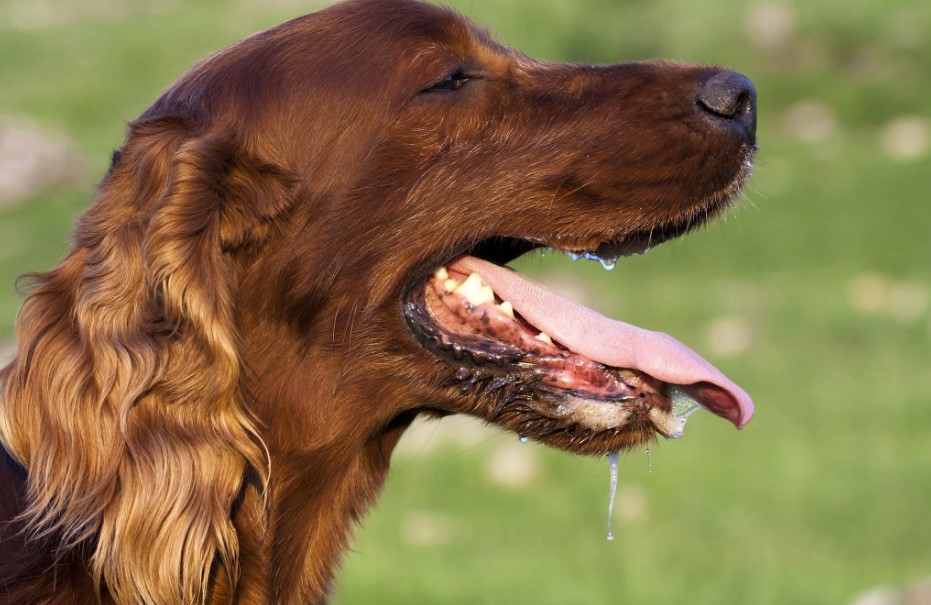If you have noticed your dog leaking clear fluid from their vulva or anus, you may be wondering why is my dog leaking clear fluid and whether you should be concerned. Clear fluid discharge can have various causes, ranging from normal physiological processes to health issues that require veterinary attention. In this article, we will explore some of the possible reasons behind your dog’s clear fluid leakage and provide some tips on how to deal with it.
Why Is My Dog Leaking Clear Fluid?
There are many potential causes, ranging from normal eye discharge to serious medical conditions. It’s crucial to consult your veterinarian immediately for a proper diagnosis and treatment plan.
Tell them about the fluid’s location, consistency, and any other concerning symptoms your dog might have. Do not hesitate, as early intervention is key for their health and well-being.
Normal Clear Fluid Discharge
One of the most common reasons for clear fluid discharge in female dogs is their heat cycle. A dog that is not spayed can have its first heat cycle as early as 6 months of age, or as late as 18 to 24 months for large or giant breeds. The heat cycle consists of four stages: proestrus, estrus, diestrus, and anestrus. During the proestrus stage, which lasts about 9 days, the dog’s vulva swells and produces bloody discharge. During the estrus stage, which lasts from 3 to 21 days, the bleeding stops and the discharge becomes clearer, indicating that the dog is ready to mate. If your female dog is not spayed, the clear fluid you see might be normal vaginal discharge from her heat cycle.
Another possible cause of clear fluid discharge in dogs is the anal sacs. The anal sacs are two small pouches located on either side of the anus that contain a foul-smelling secretion. The secretion is normally released when the dog defecates or is excited or scared, as a way of marking territory or communicating with other dogs. Sometimes, the anal sacs can become full, infected, or impacted, causing discomfort and inflammation. This can lead to clear fluid leakage from the anus, which may be accompanied by scooting, licking, or biting the area.

Abnormal Clear Fluid Discharge
While some clear fluid discharge can be normal and harmless, there are also cases where it can indicate a health problem that needs veterinary attention. Some of the signs that the discharge is abnormal are:
- It is excessive, persistent, or foul-smelling
- It contains blood, pus, or mucus
- It is accompanied by other symptoms, such as fever, pain, swelling, itching, or loss of appetite
- It affects the dog’s behavior, such as making them lethargic, depressed, or aggressive
Some of the possible health issues that can cause abnormal clear fluid discharge in dogs are:
- Vaginitis: This is the inflammation of the vagina, which can affect puppies or adult dogs. It can be caused by bacterial infection, foreign bodies, hormonal imbalance, or anatomical abnormalities. It can result in clear, cloudy, or purulent discharge from the vulva, as well as urinary incontinence, excessive licking, or pus in the urine.
- Uterine infection: This is a serious and potentially life-threatening condition that affects unspayed female dogs, especially after their heat cycle. It is caused by bacteria entering the uterus and causing inflammation, pus accumulation, and toxin release. It can result in clear, bloody, or purulent discharge from the vulva, as well as fever, lethargy, vomiting, or abdominal pain. This condition requires immediate veterinary intervention, as it can lead to septic shock or organ failure.
- Urinary tract infection: This is the infection of the bladder, urethra, or kidneys, which can affect male or female dogs of any age. It can be caused by bacteria, fungi, parasites, or stones. It can result in clear, bloody, or cloudy discharge from the urethra, as well as frequent urination, straining, pain, or blood in the urine.
- Reproductive system disorders: These are various conditions that affect the reproductive organs of male or female dogs, such as tumors, cysts, hernias, or injuries. They can result in clear, bloody, or purulent discharge from the genitals, as well as swelling, pain, or changes in the appearance or function of the organs.

How to Deal with Clear Fluid Discharge in Dogs
If you notice your dog leaking clear fluid, the first thing you should do is to identify the source and the nature of the discharge. You can do this by observing the color, odor, consistency, and frequency of the discharge, as well as the location, size, and shape of the opening it comes from. You can also check for any other symptoms or behavioral changes in your dog that may indicate a health issue.
If the discharge is normal and harmless, such as from the heat cycle or the anal sacs, you can simply keep the area clean and dry, and monitor your dog for any signs of discomfort or infection. You can also consider spaying or neutering your dog to prevent unwanted pregnancies and reduce the risk of reproductive system diseases.
If the discharge is abnormal and concerning, such as from vaginitis, uterine infection, urinary tract infection, or reproductive system disorders, you should seek veterinary advice as soon as possible. Your vet will examine your dog, perform diagnostic tests, and prescribe the appropriate treatment, which may include antibiotics, anti-inflammatories, surgery, or other procedures. Early detection and treatment can prevent complications and improve your dog’s prognosis and quality of life.
Conclusion
Clear fluid discharge in dogs can have various causes, ranging from normal physiological processes to health issues that require veterinary attention. It is important to identify the source and the nature of the discharge and to seek veterinary advice if there are concerning changes. By doing so, you can ensure your dog’s health and well-being, and enjoy a happy and long-lasting bond with your furry friend.
References & Resources
- When a female dog leaks clear fluid — What You Should Know About Canine Vaginal Discharge – PawSafe
- 6 Reasons Why Your Female Dog Is Leaking Clear Odorless Fluid – PetsBeam.com
- Dog Leaking Clear Fluid From Anus: 8 Causes Explained (joypetproducts.com)
- Why Is My Female Dog Leaking Clear Fluid? – Warmly Pet
FAQs About Dogs Leaking Clear Fluid
What could be causing my dog to leak clear fluid?
Several possibilities exist, depending on the location and other symptoms. Common causes include:
- Allergies: Runny nose or eyes due to environmental triggers.
- Urinary incontinence: Involuntary leaking of urine, common in older or spayed females.
- Vaginal discharge: Unspayed females during heat cycle, infection, or other issues.
- Anal gland problems: Leaking fluid from impacted or infected glands.
- Eye injury or irritation: Clear discharge associated with redness, squinting, or pawing.
- Dental disease: Discharge from mouth if teeth are infected or abscessed.
Is this always an emergency?
Not always, but it’s best to err on the side of caution. Consult your veterinarian if:
- The discharge is persistent or worsening.
- It’s accompanied by other symptoms like pain, fever, or lethargy.
- The leaking originates from the genitals or eyes.
- Your dog exhibits straining or difficulty urinating.
How can I tell where the leak is coming from?
Observe your dog’s behavior and the location of the wetness. Anal gland leaks typically stain near the tail, while vaginal discharge comes from the vulva. Runny noses and eyes are easily identified. Urine leaks may leave wet patches wherever your dog rests.
What should I do while waiting to see the vet?
- Monitor your dog’s behavior and symptoms.
- Gently clean the affected area with warm water and a mild pet-safe cleanser.
- Do not administer any medications or home remedies without consulting your vet.
- Confine your dog to prevent further mess or self-mutilation.
What tests might the vet run?
Depending on the suspected cause, your vet may perform:
- Physical examination: Checking overall health and the affected area.
- Urine tests: Assessing kidney function and ruling out infections.
- Blood tests: Evaluating overall health and specific conditions.
- Imaging: X-rays or ultrasounds for internal issues.
- Cytology: Microscopic examination of discharge for cell analysis.
What treatment options are available?
Treatment depends on the diagnosis. It may involve:
- Medication: Antibiotics for infections, allergy meds, pain relievers.
- Surgery: For anal gland impaction, uterine issues, or eye problems.
- Dietary changes: For food allergies or urinary tract health.
- Behavioral management: For marking or incontinence issues.







